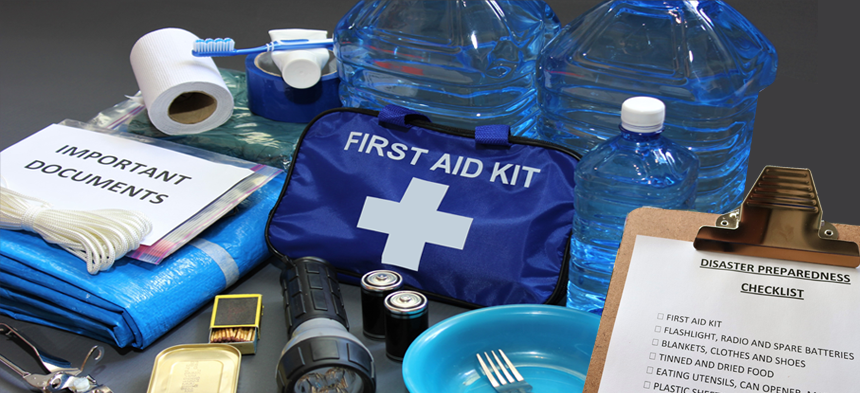Food Allergy Emergency and Disaster Preparedness
Disasters can happen at any time, often with little notice. Make sure your family is prepared.

Preparing for an Emergency
In an emergency, your family may need to shelter in place for an extended period or evacuate on short notice.
- If an emergency requires that you stay in a public shelter, be sure to identify yourself or your child as having severe food allergy. If extreme heat or cold is an issue, seek assistance in storing your labeled epinephrine in a safe, unlocked location.
- In the case of certain emergencies, like the Coronavirus (COVID-19) pandemic, you may be asked to stay home to protect yourself, your family and your community. Learn more
Whether you're stranded away from home or stuck at home, planning and preparedness are key. Here are steps you can take to help keep your family healthy and safe.
1. Create a family emergency plan
- Designate a place to go within your home in the event of natural disaster.
- If a natural disaster such as a wildfire requires evacuating your home or prevents accessing your home, identify two meeting places for your family members that are safe and away from the high-risk zones.
- Make sure everyone knows where the emergency supplies and grab-and-go bag are located.
- Select an emergency contact person who lives in a different town. Keep their contact information in writing so that it will be accessible even if your cell phone is not
- Purchase labels of a certain color (e.g., red labels for all bags and bins) so that all emergency supplies are easily identified. Include the date the kit was assembled.
- Review your plan in detail with all family members now, and at least once a year for teens and adults. Review more often for young children.
2. Assemble an emergency supply kit
Store emergency supplies in a place in your home not likely to be affected. Set a calendar alert and, at least once per year, replace expired foods and medications.
Safe foods
Choose shelf-stable products in cans, boxes or plastic, preferably ones that do not require cooking or heating. Avoid glass containers and perishable items (e.g., bakery items) that have a short shelf life.
Stick to brands you know and trust. A crisis is never a time to experiment with a new food or product. Have enough food and water for at least 72 hours. However, if a disaster is imminent, plan for 7–10 days.
A few examples include:
- Bottled water (ideally one gallon per day per person)
- Rice or other alternative milk
- Juice boxes
- Allergy-friendly cereals
- Breakfast bars
- Shelf-stable boxed bacon
- Safe chips
- Canned chicken or tuna
- Canned beans
- Fruit or applesauce cups
- Nut-free crackers and cookies
- Soy nut or sunflower butter
- Jelly in squeeze bottle
- Safe chocolate, candy or treats
- Baby food and formula
- Disposable plates, cups and utensils
- Manual can opener
Miscellaneous
- Cash and coins (ATMs may not be accessible)
- Hand or baby wipes
- Allergy-friendly personal care products (e.g., shampoo, lip balm)
- Sanitation and hygeine products
- Hand sanitizer that contains at least 60% alcohol
- Flashlight
- Batteries
- Multi-purpose tool
- Battery-operated or hand-crank radio
- Pens, notebooks
- Toys, stuffed animals, crayons
- Baby supplies (bottles, diapers)
- Pet supplies
- Pillow (feather and latex free)
- Blankets or sleeping bags
- Battery-operated candles
- Portable cell phone charger
Medical supplies
- Medications: If possible, have multiple sets in different locations and keep them with you or your child (e.g., purse, backpack, grab-and-go bag).
- Your Food Allergy & Anaphylaxis Emergency Care Plan should always be kept with your medications.
- Measuring cups or spoons for liquid medications.
- Family first aid kit including latex-free band-aids, pain relievers, anti-histamines and other trusted over-the-counter medications that may be needed.
- Hand or baby wipes
3. Assemble a grab-and-go bag
In addition to your supply kit, consider stocking a grab-and-go bag, which is smaller version of your supply kit that includes essential food, medical supplies, and documentation that you can easily carry or thrown into the car at a moment's notice.
Important documents
Start with a notebook and record contact information for anyone you may need to reach. Include phone numbers for your family’s physicians and pharmacist. You or your child may need refills or require care from a physician who is unfamiliar with your family’s medical needs.You may also want to include:
- Copies of personal documents (driver's license, proof of address, deed/lease to home, passports, birth certificates, insurance policies)
- Local maps
- List of hospitals in surrounding areas
- Food Allergy & Anaphylaxis Emergency Care Plan
- Physician’s letter detailing how you or your child should be treated in the event of an allergic reaction or anaphylaxis.
- Healthcare provider contact information (your phone may not work)
- Pharmacy phone number
- Written list of all medications
- Copy of insurance cards for all family members
- Additional written prescriptions or copies of prescriptions (in case medications need to be replaced)
- If enrolled in a clinical trial, have the principal investigator contact info and NCT trial number
Additional Resources
Regardless of where you live, having a disaster plan is essential. For more information on preparedness:


